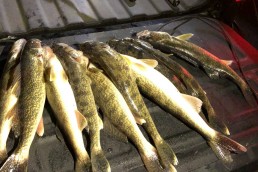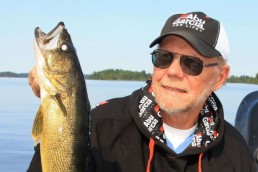Following the Freeze-up: Cash in on Early Walleyes
SHARE THIS POST
The race is on to get out on the lakes and begin the ice fishing season. Each year the lakes will freeze in a somewhat predictable order, with the shallow lakes freezing first and the deep lakes last. Anglers can have their ice fishing plan scripted out for which lakes and what locations before the season is fully underway.
Based on experiences and observations from past seasons, anglers can know where to walk out on the ice.
One of the first places in my area to have “good” ice is Upper Red Lake and Lake of the Woods. Both lakes are big, shallow, and are located north enough to have “walkable” ice earlier than most lakes closer to my home in Max, Minn. Usually, these two lakes will be ready to walk on before places like Lake Bemidji and Walker Bay on Leech Lake will even have finished freezing over completely.
I also know that both Upper Red Lake and Lake of the Woods will have ice thick enough for vehicles to drive on at about the same time Bemidji and Walker Bay are ready for ATVs. There is a big difference in ice thickness between lakes early in the season, while later in the winter the differences become less meaningful.
Virtually all of the walleye action early in the season is either on shoreline-connected structures or ones close to shore. Anglers walking out on the lakes want to fish locations close to the access points and do not want to have to cross over deep-water levels under the ice.
Most serious ice anglers will have their traditional spots where they can walk on “first ice.” The best locations are private accesses, but theses are mostly unavailable.
Once the ice is thick enough to drive ATVs and eventually other vehicles, the race really begins. Anglers often rush onto the lakes like the old homesteaders, as soon as the ice is safe, trying to “stake their claim” to their favorite spot before anyone else can beat them there.
Resorts with paid access on the lakes are responsible for monitoring the ice conditions early in the season. They decide when the ice is ready for anglers. They also decide what mode of traffic is allowed on the ice, with walking first, then ATVs and finally full-sized vehicles pulling big fish houses.
Part of the scripted plan for the ice fishing season not only includes what lakes to fish first, but also when to make the switch to other lakes and being able to follow the progression of “first ice” from lake to lake and each freezing process timetable.
There is another “rush” when the lakes have enough ice for anglers to spread out on the lake and leave the shoreline for the mid-lake structures farther from shore.
Are you enjoying this post?
You can be among the first to get the latest info on where to go, what to use and how to use it!
Shoreline structures can refresh more easily with new fish, especially if the location is loaded with baitfish. Anglers may be able to have success near an ideal shoreline day after day, with the bite holding out as long as the schools of baitfish remain in the general area.
Mid-lake structures are often different from shoreline structures and don’t refresh as quickly with new fish. What’s there is there, especially when the structures are isolated from other structures.
Sometimes fishing mid-lake structures is like being the second guy to find King Tut’s Tomb; the first guy already got all the gold, so there is nothing but scraps left behind. Anglers can break open a new hump and catch 20 fish the first night and then nothing the second time they fish the spot. This happens because there is a limited amount of fish on any one hump, so the bite is hot at first, then drops off quickly when the fish get caught.
If I come up on a hump and find it already drilled out, I am likely to pass it by, unless the holes the previous anglers drilled missed my favorite part of the structure. Even then, if I drill a few holes and give it a try, it is unlikely to hold my interest for very long if I don’t catch or see some fish quickly.
An unfortunate trend in ice fishing today is for anglers to drill way more holes than they need to in order to check out a spot. Pay attention to the water clarity in the lake. The clearer the water, the farther the fish can see. Then fewer holes farther apart can cover more area and there’s less noise.
Drill all the holes at one time to get the noise over with—let things settle down. Drill the holes strategically, so you can cover the area efficiently. Don’t overlap too much between holes, especially in clear- water lakes.
Wait to drill more holes until the bite slows down, and don’t drill when fish are active or during prime time. Making noise when nothing is happening makes much more sense. It can be like reshuffling the deck when playing cards; you “move” the fish around and get a new “hand” to play.
Each lake can fish differently for walleyes. Some lakes are strictly morning and evening lakes, while others can have more walleyes roaming around periodically during the day. Stained-water lakes tend to be better during the day, while clear lakes tend to be better under low-light conditions.
I like to use an active presentation on my main line I fish out of the same hole as my sonar. I use a combination of Buckshot Rattle Spoons or Puppet Minnows on pre-rigged Bro-Series Rods, so I can change presentations fast if I get a fish that comes through and doesn’t bite on the lure.
I also like to take advantage of the “second line” anglers are allowed in Minnesota and many other states during the winter. Instead of a bobber rig or a tip-up, I like to use one of my Frabill Bro Series Dead Sticks with a New Bro Band to gently hold the line on the reel with an open bail. The fish can easily slide the line out of the Bro Band and run with the bait when I get a bite.
MWO
SHARE THIS POST
Did you enjoy this post?
You can be among the first to get the latest info on where to go, what to use and how to use it!
Brian 'Bro' Brosdahl
Outdoor communicator Brian “Bro” Brosdahl lives in northern Minnesota. He is a walleye guide in the Cass Lake, Leech Lake and Lake Winnibigoshish areas. He is sponsored by Northland Fishing Tackle, Frabill/Plano, Aqua-Vu, Humminbird/Minn Kota, St. Croix Rods, Ranger Boats, and Evinrude. Guide inquiries: brosguideservice.com. Follow on social media.




